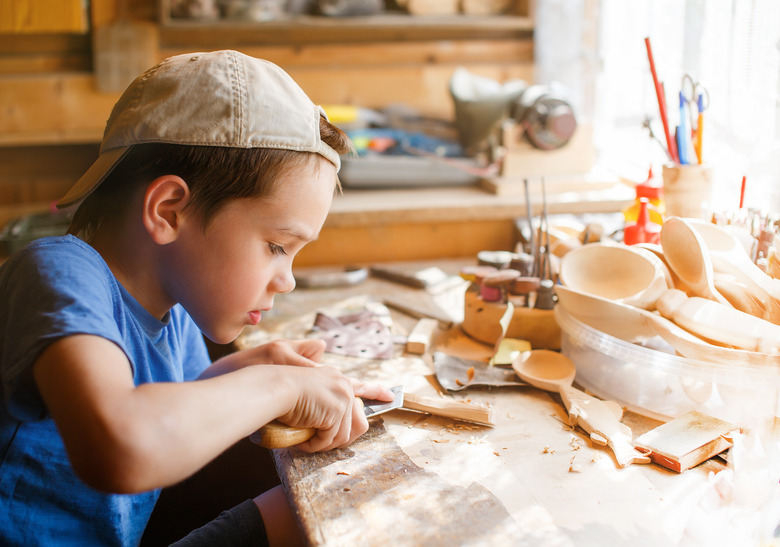How To Build A Mini Electric Car For A Science Project
The components you need to make an electric car include a chassis, some wheels and axles, an electric motor, a power source such as a battery, and some kind of gear, pulley mechanism or fan that allows the motor to propel the vehicle. Although anyone who builds a tiny car is constrained to include all these components, there is plenty of room for creativity when choosing materials and drawing up designs. To illustrate, consider two different mini cars made from very different materials.
The Basic Woody
The Basic Woody
The Woody has a flat, rectangular chassis made from balsa wood or some other lightweight wood. It should be about 1/4 inch thick, which allows you to screw four small screw eyes to the underside through which you can poke wooden skewers to form the axles. Fender washers make great wheels – they are about an inch in diameter and have tiny holes through which you can insert the skewers and secure them with hot melt glue. Test the car by rolling it on a table to make sure all four wheels turn freely.
You can obtain a small electric motor at a hobby store, or perhaps salvage one from an old personal fan. Glue the motor to the surface of the chassis so that the shaft hangs over the side of the vehicle and sticks out about 1/2 inch. Mount a 9-volt or AA battery on the other side of the chassis to supply power. Use a rubber band to connect the motor shaft to one of the rear axles just behind one of the wheels, and you're ready to power up.
You'll need to devise a switch, but before you do, touch the motor leads to the battery terminals to make sure the motor works and that the wheels turn. Now wrap one of the wires around a metal screw and drive the screw into the chassis. Wrap the other wire around a bare metal paper clip and, using a screw and a small washer, screw the clip to the top to chassis. It should be tight enough to stay in place, but loose enough to allow you to rotate it with your finger. Mount it close enough to the screw to allow it to make contact when you push it in that direction, and you have your switch.
The Fantom Flyer
The Fantom Flyer
The chassis, wheels and drive mechanism for the Fantom Flyer are all made of recycled plastic objects you have around the house. The only wooden items you need are the skewers used for the axles of the Woody.
Cut the top off a 1-quart plastic soft drink bottle, making the cut about 3 inches from the mouth of the bottle. Save the top and the cap – you'll need these later. Punch holes in the side of the bottle, insert a plastic drinking straw, and then poke two more and insert another straw. The straws are the wheel axles, and they should be about 8 inches apart. Secure them with hot melt glue and then cut them so they extend about an inch past the sides of the bottle.
Insert a wooden skewer into each straw and push it in until it emerges from the other end. Get four plastic caps from pill bottles, poke a hole in the center of each one, and secure one to the end of each skewer and glue it. These are the wheels, so make sure the caps you use are all the same size. Test the vehicle – as you roll it on the table, the wheels should turn freely.
Mount the motor and battery on the other side of the bottle with glue. The motor should be mounted on the rear of the vehicle – which can be the open or closed end of the bottle – with the shaft sticking out an inch.
To construct the fan that will propel this vehicle, make cuts on the bottle top that extend down from the cap, using a utility knife. The cuts should be about an inch apart. When you're done cutting, push down on the bottle cap to make the sections splay out and create a fan. Poke a hole in the bottle cap and secure the fan to the motor shaft wth glue. When you connect the battery, the fan will spin, and the car will take off into the sunset.
Cite This Article
MLA
Deziel, Chris. "How To Build A Mini Electric Car For A Science Project" sciencing.com, https://www.sciencing.com/build-electric-car-science-project-8035033/. 9 March 2018.
APA
Deziel, Chris. (2018, March 9). How To Build A Mini Electric Car For A Science Project. sciencing.com. Retrieved from https://www.sciencing.com/build-electric-car-science-project-8035033/
Chicago
Deziel, Chris. How To Build A Mini Electric Car For A Science Project last modified August 30, 2022. https://www.sciencing.com/build-electric-car-science-project-8035033/
